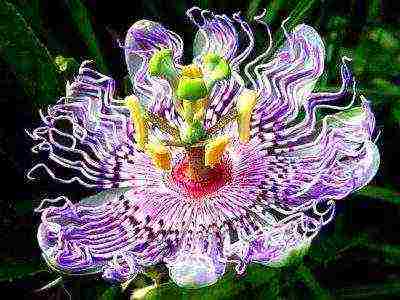Content
- 1 Houseplants are not small copies of garden forms
- 2 Potted Chrysanthemum Varieties
- 3 Chrysanthemum care at home
- 4 Reproduction of chrysanthemums at home
- 5 The main problems when growing a plant
- 6 Diseases and pests of indoor chrysanthemum
- 7 Lush blooms on a staggering scale
- 8 What to look for when buying
- 9 Wintering is most important
- 10 Light mode for potted chrysanthemums
- 11 Temperature regimes
- 12 Watering for potted chrysanthemums
- 13 Air humidity
- 14 Top dressing for pot stars
- 15 Pruning and shaping bushes
- 16 Potted chrysanthemum breeding methods:
- 17 Common problems and diseases:
- 18 Potted chrysanthemums are used for:
- 19 Chrysanthemums: care and cultivation
- 20 Reproduction
Luxurious inflorescences in autumn flower beds attract the eye and amaze with a variety of shades. Indoor chrysanthemum in a pot differs from its congeners in the open field in the compact shape of a spherical bush with a height of 20–40 cm. Breeders have bred several hybrids and varieties adapted to the lack of lighting and other indoor conditions.
Houseplants are not small copies of garden forms
"Home" chrysanthemums are not demanding to care, grow well, bloom profusely and multiply easily. In everyday life, it is customary to say "flowers", although the Compositae family has an inflorescence-basket. When buying, you should pay attention to the fact that there is a healthy chrysanthemum in a pot, care at home will then be much easier. A well-developed indoor plant will continue to bloom on the windowsill. Under favorable conditions, the buds can bloom almost without interruption for 2 years.

It should be noted that after independent propagation by cuttings or root suckers, new plants do not turn out to be as compact and dense as those purchased in the store.
Street chrysanthemums are sold in plastic containers. Such flowers are planted in open ground, or left in a container, used for container gardening, patio decoration, house entrance. After flowering, the stems are cut, containers with roots are sent to the basement or loggia for the winter. If street chrysanthemum is kept indoors, its leaves will turn yellow and dry. These plants need fresh air and a certain lighting regime - the night is longer than the day.
Potted Chrysanthemum Varieties
Thanks to the efforts of breeders, geneticists and agrochemists, plants have been bred that can bloom profusely and for a long time in a room. In total, about 40 hybrid varieties of chrysanthemums have been created for indoor cultivation. The inflorescences can be smaller or the same size as those of open field plants. Varieties are often grouped by origin from one natural species.
Chrysanthemum indian
In nature, this is a relatively low herbaceous plant. The leaves are serrated, green-gray in color. The inflorescence is a basket resembling a chamomile with yellow petals and the same core. It is the ancestor of small-flowered hybrids for growing on windowsills and balconies.
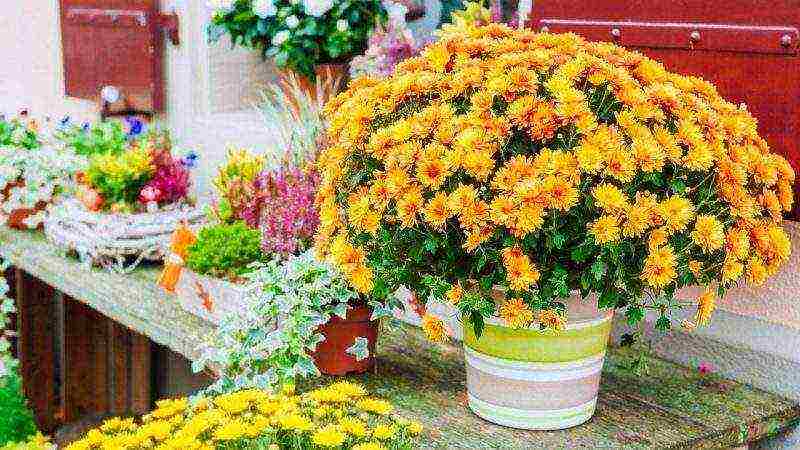
The Indian chrysanthemum was crossed with species that have white and pink inflorescences. Breeders, with the help of chemicals that affect growth, have obtained compact forms with a height of 20-25 cm. Today there are a large number of various forms and varieties that feel good in the room and are in high demand. The flower is liked and appreciated for its rich color and long flowering, which is especially attractive in the cold season.
Popular varieties of chrysanthemums in indoor floriculture:
- "Golden Gloria" - dense bushes with many large yellow inflorescences.
- "Old Gold" - plants with petals of an unusual reddish-bronze color.
- "Morifolium" is a variety with large, simple, semi-double and double inflorescences 5 cm in diameter.
Chrysanthemum Chinese or mulberry

A group of varieties and hybrids, for the creation of which several species were used. Plants for indoor floriculture have a compact shape, thin, highly branched stems 20–25 cm high. The leaves are deep green, 7 cm long and 4–5 cm wide. On the upper side of the leaf blade, pinpoint glands are noticeable. Inflorescences of Chinese chrysanthemums are simple, semi-double and double, of various sizes and colors.
Chrysanthemum care at home
They buy a plant in a flower shop or accept it as a gift. In any case, it is necessary to create conditions in the new room so that the buds do not fall off. Planting and caring for a chrysanthemum in a room is different from open ground and a greenhouse.
Lighting, temperature control
Light affects flowering and bud opening. The amount of light is suitable that is provided by placing the pot on the windowsill of plastic or wooden windows facing west and east. The hit of rays at noon can cause burns to the leaves, in this situation it is recommended to shade the plant. A young bush blooms with 6-8 hours of daylight in October or November (depending on the region).
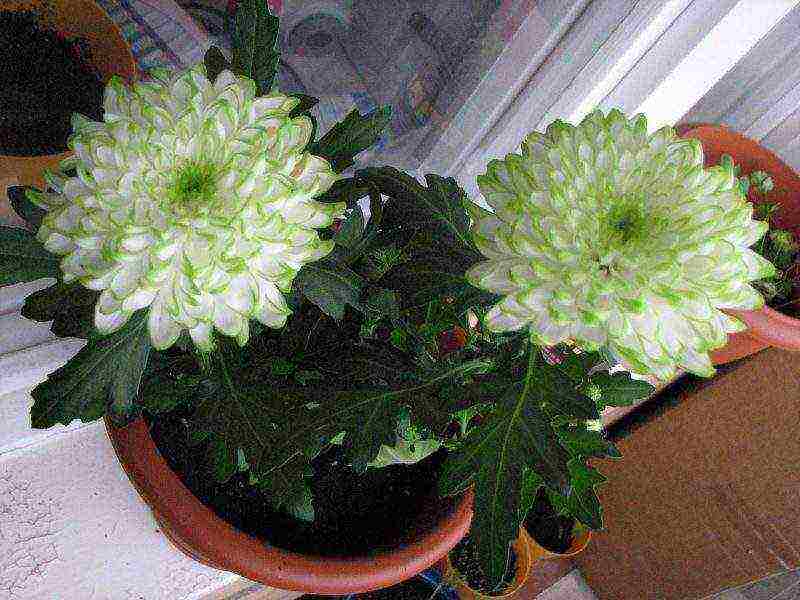
A comfortable temperature for a room chrysanthemum is 18–23 ° С. The variety, more demanding in terms of keeping conditions, reacts to the heat by dropping buds and leaves. It is advisable to spray the plant with water more often in the summer to reduce the temperature. You can leave in front of an open window, the chrysanthemum is not afraid of drafts.
Watering and feeding
The soil in the pot should always be moist. Indoor chrysanthemum prefers frequent irrigation, but not excessive. Stagnant water in a pot can lead to root rot, the spread of fungal and bacterial diseases.

Recommendations for flower growers:
- The substrate should not be allowed to dry out.
- In autumn and winter, watered once a week in the morning.
- Watering in spring and summer is carried out 2 times a week in the evening.
- In the heat, water is sprayed near indoor plants to reduce the air temperature.
- Used for watering and spraying the settled water. If it is tough, then white bloom accumulates on the soil surface.
- Avoid getting drops on flowers.
Profusely blooming chrysanthemums require more frequent fertilization. Liquid dressing is carried out once a week until the end of flowering. It is advisable to use complex fertilizers with the addition of trace elements. Actively growing shoots need nitrogen; during budding and flowering, more potassium and phosphorus are required. The potted plant is fed about 12 hours after watering.
Pruning and shaping the bush
The purchased plant retains its original shape for a long time. If in the future you do not regulate the growth of shoots, then several long stems appear, which reduces decorativeness.
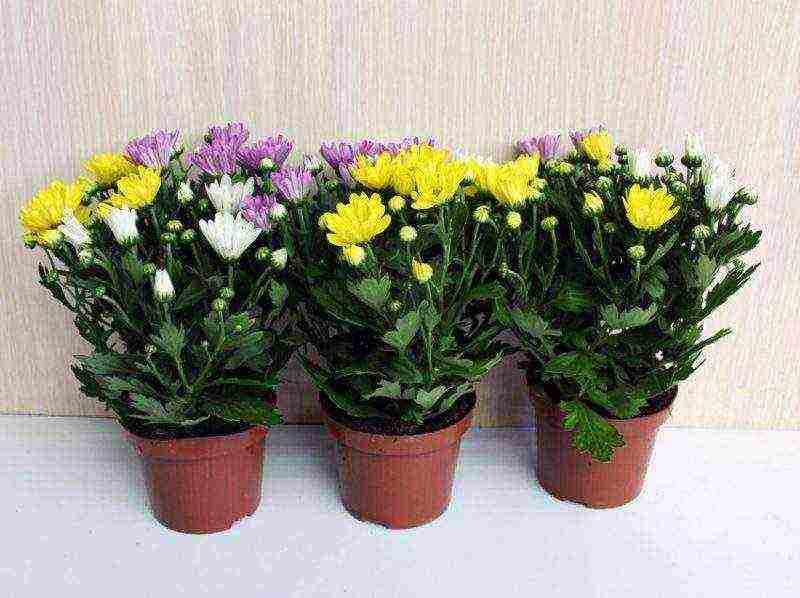
Recommendations:
- Pinching of rapidly growing shoots is performed. Small-flowered chrysanthemums will need 2 or 3 treatments.
- Large-flowered hybrids can be formed in the form of a tree by shortening the main shoot and cutting off the lower branches.
- Pinching buds that are starting to wither helps to increase the number of new buds.
Pruning is needed if flowering is delayed. Selective pinching of the tops of the flower stalks will ensure the flow of nutrients to the remaining buds.
Plant transplant
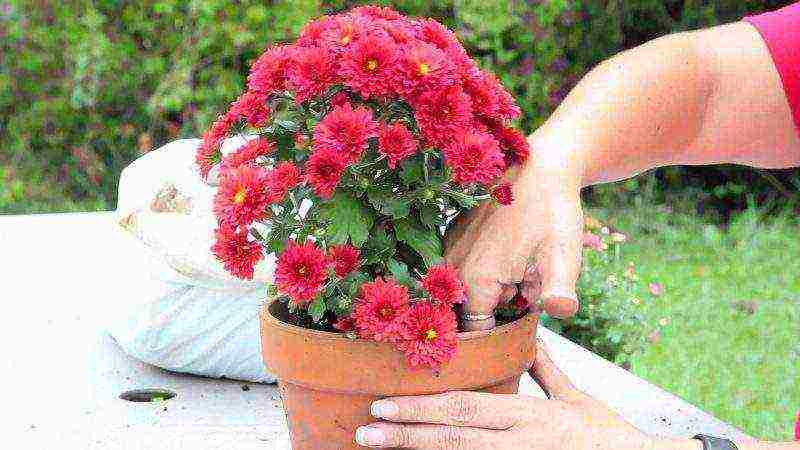
Young and old plants need to renew the substrate. They are transferred into a deeper and wider pot once a year - in spring or early summer. The substrate is prepared from garden soil, peat and humus (1: 1: 1). You can use ready-made potting soil.
For chrysanthemums, such indicators as a loose structure, lightness, moisture content and nutritional value of the soil (mechanical composition and fertility) are important.
After transplanting, young offspring are covered with a plastic cup, adult plants - with a plastic bag. Provide diffused lighting at first, do not forget about watering.
Features of care after flowering
After the end of flowering, weak and diseased shoots are removed. Some growers recommend pruning the stems, leaving short areas above the surface of the substrate. After that, the soil is watered and the pot is removed to a cool, dry place until spring.
You can do without radical pruning at the root, leave the chrysanthemum as it was on the windowsill in the room. The third option: to stimulate the growth of shoots and the formation of a compact bush, pruning is done, but the pot is not removed. A strong chrysanthemum in the same season will start up new shoots and bloom.
Reproduction of chrysanthemums at home
Adult chrysanthemums "acquire" root suckers (babies). Young plants can be grown from these additional shoots. Root offspring are carefully separated from the mother bush, planted in small containers. It is necessary to keep the depth of the plant at the same level. To do this, increase the height of the drainage layer or place the roots higher. Cover the seedlings with a plastic cup. In the autumn of the same year, young plants will bloom.
Rooting stem cuttings:
- Young shoots are cut from an adult plant.
- Fill a clear plastic cookie or cake container with well-rinsed sand.
- Cuttings are planted, covered with a lid from the container.
- After the formation of roots and the appearance of new leaves, young plants are transplanted into a pot.
Chrysanthemums are difficult to grow from seeds. Hybrid varieties are often sterile. Usually, during seed propagation of chrysanthemums, varietal characteristics are not preserved.
The main problems when growing a plant
Why do the leaves turn yellow?
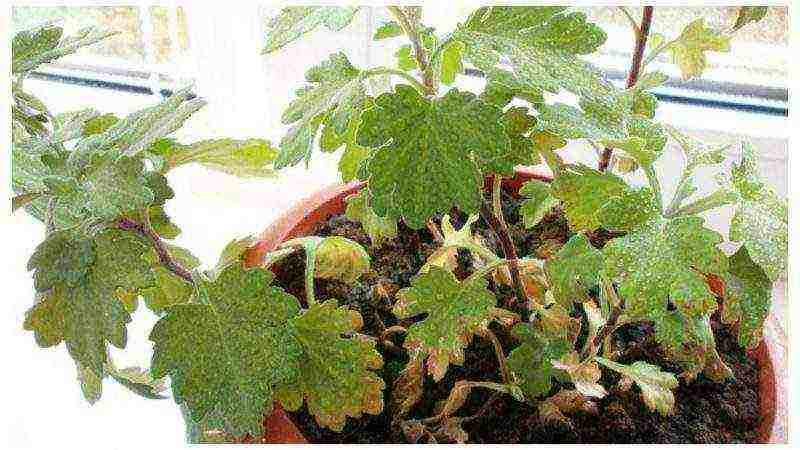
Chrysanthemum leaves change color due to improper care and diseases. Yellowing may be due to a lack of light, water, hot air from the radiator. The appearance of spots of a grayish-yellow or brown color with a yellow border is a sign of a fungal infection. If yellowing is associated with poor care, then it is easier to correct this deficiency than to cure plant diseases.
Chrysanthemum does not bloom - why?
Typical reasons for the lack of buds and flowers are lack or excess of lighting. Chrysanthemum is a short day plant. If there is artificial lighting in the room in the morning and in the evening, then biorhythms go astray. Another reason is associated with the rapid growth of stems and leaves, which happens when there is an excess of fertilizing and no pruning.
Diseases and pests of indoor chrysanthemum
The plant is prone to rust, powdery mildew, gray and black rot. For these fungal infections, they are treated with fungicides for indoor plants. Chrysanthemum is damaged by aphids, black midges sciarids, soil mites, springtails. The leaves are treated with a solution of the drug Aktellik, Fitoverm or Bazudin. For spraying, the flowers are taken out to the balcony. Window sills, window frames are washed with a solution of soda and soap.

After the death of the pests, the top layer of the soil in the pot is changed to a depth of 2 cm. It is recommended to carefully consider the choice of the substrate.Typically, pathogens and plant pests are found in the land brought from the garden and vegetable garden.
It is very important to isolate the affected plant from the rest of the green pets in the room, to carry out pest and disease control in a timely manner. Then the chrysanthemums will remain healthy, will delight with flowering for a long time.

For cultivation on the site, two varieties are used: ground chrysanthemum and Korean.
Chrysanthemum belongs to the Asteraceae family. The flowering period lasts from September to October. Leaves are sessile, green with a gray tinge, erect stems.
The height of the shrub can vary from 30 to 110 cm. The larger the shrub, the more flowers are formed on it, under favorable conditions it can grow up to 100 inflorescences with a double or semi-double surface. The rhizomes of the plant are branched, with root shoots, penetrate into the soil to a depth of 25 cm.
The inflorescence of the chrysanthemum is a basket, it contains a large number of individual flowers.
The diameter of the inflorescence ranges on average from 5 to 10 cm. The shape of the flowers can be varied: flat, pompous, anemone. The color has a wide palette, the petals can be lilac, orange, crimson, pink, red, white, orange. A pleasant light aroma emanates from the flowers.
Chrysanthemums are planted in group plantings, combining shrubs with flowers of different shades. Chrysanthemums complement those trees that change the color of their foliage with the change of season. You can also do group plantings with other perennial herbaceous plants or shrubs.
The most common types that are grown on sites:
- The crowned chrysanthemum has a simple stem, the height reaches 70 cm, although it may be less. Basal leaves do not stay on the plant for a long time. Inflorescences are single or collected in groups. Leaves of this type can be used for food.
- Chrysanthemum alpine low-growing plant, average height 15 cm. Leaves are collected in a rosette, single baskets, 3 cm in diameter. The flowering period lasts from July to August. This variety looks great on alpine slides, it is also grown in pots, borders.
- Chrysanthemum keeled is an annual species, it grows from 20 to 70 cm. The stem is erect, fleshy, the leaves are also dense. Inflorescences can be double and semi-double, have a pronounced aroma. The flowering period lasts from June to September, the flowering is abundant.
- Shrub chrysanthemum is a tall species, reaching 1 meter. Inflorescences are large, reach 5 cm in diameter, double or semi-double, can be located singly or in groups of 2-10 pieces. Flowers are tubular or ligulate.
- Chrysanthemum mulberry (Chinese) - bred artificially, this is a low-growing plant whose height ranges from 30 to 130 cm. The shoots are erect, lignify over time. Inflorescences can be simple, semi-double or double, reach an average of 6 cm in diameter, emit a pleasant light aroma.
- Korean chrysanthemums originated in a hybrid way. Flowers can reach a diameter of 15 cm, the maximum height of the shrub is 1 meter.
Hybrid varieties are easier to tolerate bad weather and temperature changes. They are less likely to encounter diseases and pests, and have a long flowering period.
Growing chrysanthemums from seeds
Growing chrysanthemums from seeds does not require much time and special conditions. The plant is not whimsical and adapts well to environmental conditions. Not all types of chrysanthemums are grown from seeds, only some annual species, as well as Korean small-flowered representatives, are suitable. Other types of chrysanthemums can only be obtained by dividing the bush or by cuttings.
Sowing seeds of annual chrysanthemums can be done directly in open ground.
This is done in mid-May.Flowering occurs only in autumn, but if you want to see flowers as quickly as possible, then seedlings are planted, it quickly adapts to open ground and environmental conditions. The seeds of perennial chrysanthemums are sown at the end of January. If the winter turned out to be cold, then you can wait another month and sow chrysanthemums in February. The development of seedlings is slow, so if you plant a flower in the spring or later, then flowering will come only next year.
Soil for sowing seeds needs light, you can prepare it according to the following scheme:
- 1 part sand
- 1 part humus
- 2 pieces of leafy land
Expanded clay, gravel or other material that acts as drainage must be placed on the bottom of the seedling container. The seeds of annual species are planted to a depth of no more than 1 cm. If the chrysanthemum is Korean, then the seeds are laid out on the surface. The sprouts will appear in about 2 weeks; under favorable conditions, the period may be reduced.
While the seedlings are in containers, the ambient temperature should be within 18 degrees. The soil must be constantly moist, for this it is periodically sprayed from a spray bottle, preventing it from drying out. The water for spraying is warm and settled. When several full-fledged leaves appear, the plants dive into separate containers.
Seedlings are transplanted into open ground in early June, and if the weather permits, then a little earlier.
An open, sunny place is chosen on the site. Groundwater should not pass close to the surface, chrysanthemums do not like stagnant water. The soil should be light and fertile. In the fall, chrysanthemums are dug up and stored until spring in a cool room. This is done only in the first year while the plants have not yet matured. Further, no shelter is required for the winter, especially if the winter is mild.
Planting chrysanthemums in open ground
It is very easy to grow chrysanthemums outdoors, but this does not mean that it does not require special conditions:
- The most important thing is to choose a sunny area.
- In addition, the plant should not be affected by wind and drafts, so it is advisable that the flowers be blocked by a fence or a house.
- For chrysanthemums, you need to find a flat area. This is due to the spring period, if the flowers are planted in the lowlands, that is, there is a great risk that during the melting of the snow, the water will drain and flood the plants. The same goes for rainy weather, a large amount of water can lead to the death of plants.
- The ideal option for chrysanthemums is a place near hedges, it will let light through for flowers and protect from bad weather.
The flowering period of most varieties falls in the fall, so the light regime should be as natural as possible. If you make changes, then the petals of the flower can change their structure, the stem becomes less durable, the decorative effect of the flower is significantly reduced.
If there is not enough sun for the flower, only flower buds will form. If the daylight hours are increased, then axillary buds, leaves and stems will be laid. That is, for the normal life of a plant, it needs an ordinary daylight hours so that all processes go on as usual.
If it is necessary for the chrysanthemum to bloom a little earlier, then during the formation of buds, the plant is covered from the sun. Then flowering can start 2 weeks earlier.
The Korean variety is the most hardy among the rest.
After winter, it begins to actively develop at temperatures from 2 degrees Celsius. If autumn began early and the first frosts fell during the flowering period, then this is not a big deal, chrysanthemum can withstand temperatures down to -10 degrees. If during the autumn frosts the plant froze, then after a while it can thaw and continue to bloom.
Chrysanthemum tolerates heat harder than cold.On summer days, generative organs are laid, so the plant may underdevelop. In open ground, chrysanthemums are planted at the very beginning of summer or at the end of May. You need to focus on the temperature of the soil, it should have time to warm up to 14 degrees, you need to check the temperature at a depth of at least 20 cm.
Watering chrysanthemums:
- Be sure to water the plants after planting, it is especially important to do this in July.
- If there is a lack of moisture, especially in sunny, dry weather, flower buds may not form. It is from them that inflorescences will grow in the future.
- If the soil does not have time to dry out due to the large amount of precipitation, then there is no need to water the plant.
- With an excess of moisture, the plant will not feel bad, but the more juicy the shoots are, the greater the risk that they will freeze during autumn frosts.
Do not forget to moisten the soil in the first weeks after planting seedlings or cuttings that have not yet been rooted. The soil should be fertile, preferably loamy, with an acidity of 6.5. Loamy soil retains heat well and can protect the flower during cold weather.
To grow chrysanthemums on sandy soil, peat and humus will need to be added to it during digging. If the plants get into the garden of their greenhouse, then it is better to store them indoors for the winter as well.
Planting indoor chrysanthemums
Chrysanthemums are often grown indoors. In order for chrysanthemums not only to actively develop, but also to bloom in a pot, it is necessary to select good soil.
You can purchase a special composition in the store, or you can cook it yourself, for this, the following components are used:
- Garden arable land
- Coarse sand
- Granular peat
- Bone flour
If you take a bucket of soil, then bone meal will need a small pot, about 7 cm in size. The pot is not completely filled with compost, 1/3 of the container is not poured. A sprout is placed in the mixture. It is installed so that the roots are on the surface, after which the remaining compost is filled up. You do not need to press down firmly on the ground after planting, so as not to damage the roots. Also, several plants should not be close to each other.
At the initial stage of cultivation, the soil is moistened with a spray bottle, it should not have time to dry out.
The sprouts must immediately be provided with bright sunlight. The optimum temperature at night is up to 10 degrees Celsius. Within a month, the root system should completely fill the pot. After that, the young plant is transplanted into a larger pot. For adult plants, a slightly different soil composition will be required, it will include the following components:
- 1 part sand
- 1 part peat
- 3 parts garden soil
- 0.5 parts dry manure
- Handful of bone meal
Watering is carried out the day before the chrysanthemum is transplanted into a new pot and immediately after. Until the stems of the plant have grown stronger, they will need support. It is not necessary to repot the plant anymore, only if the roots have made their way to the surface of the earth.
Chrysanthemums are not only able to decorate any interior. They are prized for the ability to grow them for cutting. For the latter, annual species are used, in particular keeled chrysanthemum. In order for potted chrysanthemums to develop more actively, various stimulating biological products can be used. They activate the growth of dormant buds, after which the crown becomes denser, and more buds are formed.
The following drugs are used:
- Planta Miracle-Growth
- Bud
- Epin
- Zircon
It has been experimentally proven that the use of a light solution of potassium humate leads to an acceleration of plant development, an increase in the volume of the root system, an increase in the size of buds and the general decorative effect of plants.
Reproduction, caring for chrysanthemums and possible problems
Chrysanthemums can be propagated in several ways:
- Rhizome division
- By cuttings
Each method has its own characteristics, advantages and disadvantages.The division of the bush is done immediately after winter. It is necessary to have time to do this before young shoots appear. In the evening, the shrub is dug out of the ground, and the rhizome is divided into several parts. These parts are treated with a solution of potassium permanganate and planted on the site.
The plot is chosen sunny, a distance of 50 cm is kept between the shrubs. Watering is carried out in a thin stream right at the root. In autumn, a part of the shrubbery bends over and is buried in the ground. To keep the branch well, staples are used. In the spring, a new shoot with its own root system will begin to grow from this place. In May, the soil is harvested and a new shoot is cut off. It can be left in the same place or transplanted to a new one.
The easiest way to propagate chrysanthemum by cuttings. In addition, it is guaranteed that you will get the same beautiful bush as an adult. The procedure is carried out in the spring and summer.
Chrysanthemum cuttings:
- After the threat of frost has passed and the ground has thawed at a depth of 30 cm, suitable mother bushes are selected, the life of which is more than 1 year.
- Flowers can be fed before breeding.
- When the ambient temperature reaches +18 degrees, you can see that new shoots with matte leaves appear on the shrub. These shoots will be used for propagation and are pruned when they are no more than 25 cm in length.
- In order for rooting to take place successfully, a plot of land with rich loosened soil is prepared, shading is done.
- There should be a distance of 20 cm between the cuttings.
The first month you need to carefully monitor the soil moisture, otherwise the roots will not form. At first it may seem that the cuttings are withering, but when the root system is formed, they will come to life and begin to actively grow.
Young chrysanthemums need feeding every 2 weeks, if the weather is unfavorable or the soil is poor, then fertilization can be applied every week.
If a large number of buds or peduncles have formed, then it is advisable to remove the smallest and weakest ones. Then the rest will be largest and brighter.
The most common diseases and pests of chrysanthemums:
- Gray rot
- Powdery mildew
- Leaf rust
- Root bacterial cancer
- Leaf spot
- Aphid
- Meadow bug
- Chrysanthemum nematode
Most of the problems arise from improper care of the chrysanthemum, in particular, insufficient or excessive watering. High humidity can lead to diseases.
Chrysanthemum is an unpretentious plant, however, certain conditions must be observed to obtain a lush shrub. Nutritious soil and bright light are the main factors for large, bright flowers.
It is impossible not to succumb to the charm of potted chrysanthemums. Huge "sheaves" or balls, covered with so many flowers that seem almost like pillows on the eve of autumn, flood the markets and flower shops. A more popular and common seasonal pot is not found. Chrysanthemums are used to decorate gardens and terraces, facades and front gardens, balconies and apartments. All potted chrysanthemums have one thing in common - low winter hardiness. She determines the specifics of the cultivation of the main autumn soloists.
Lush blooms on a staggering scale
Chrysanthemums are so popular at the end of the season not only because the color palette perfectly represents the so-called autumn palette. The colors of the chrysanthemum flowers really perfectly emphasize the crimson-fiery autumn range. But no color nuances can overshadow the main thing - relentless and very long flowering, unique in its scale and abundance. In addition, potted chrysanthemums are very diverse in varietal colors.
Potted chrysanthemums that cannot withstand winter frosts can be grown in two forms:
- Seasonal indoor or balcony annual;
- A perennial that is taken indoors for the winter and cut off after a dormant period, stimulating growth.
Potted chrysanthemums can also be planted in open soil - but then they will need to be dug up and transferred to pots for the winter. Therefore, they are more often grown in container culture.
Chrysanthemums in container form are different from their garden counterparts. They develop in the form of dense cushion-shaped bushes, formed by pruning and bred specifically to obtain specimens of increased density. Numerous shoots are woody, dotted with simple carved leaves, which most often do not create a particularly impressive crown, but only serve as a background for flowers. They bloom at the tops of the shoots in such numbers that they create solid caps.
Classic inflorescences-baskets in potted chrysanthemums are both simple and densely double, with wider or very narrow reed petals. And the color, which includes all the warm shades of white-cream, yellow, orange, red, purple, brown palette, can be both monochromatic and combined and even contrasting.
New in fashion today blue-colored chrysanthemums and original green-colored plants, as well as varieties with dazzling acrylic colors. Even more popular are large-flowered varieties - hybrids with spherical, pompom, anemone-shaped inflorescences, which adorn gardens during all warm months, and bloom in indoor culture all autumn and winter.
Pot chrysanthemums vary in size. For indoor culture and indoor cultivation choose mini-varieties, the height of which does not exceed 30 cm. But the intended for open air specimens are twice as large, sometimes reaching 1 meter in height and diameter. Potted chrysanthemums are standard, and formed in the form of a ball, and squat, and even sloping. In short, there is plenty to choose from. Moreover, indoor chrysanthemums are sold in bloom throughout the year, and garden chrysanthemums are now on the shelves in spring, and are specially driven out at atypical times. But such early maturing plants are just a temporary decoration of both the house and the garden, which will have to be thrown away. If you want to preserve chrysanthemums, buy them during their typical flowering times, from late summer through fall. When buying, be sure to specify exactly what conditions the chrysanthemums are accustomed to and how they need to be grown: sometimes chrysanthemums of local distillation require specific care.
In order for potted chrysanthemums to bloom truly profusely, they will need simple but constant care and rather specific conditions. They bloom luxuriantly at low temperatures, and this requirement can be ignored only when grown as an annual or by a callout in fresh air. Watering and feeding are frequent, but other than them, no difficulties with chrysanthemums usually arise.
What to look for when buying
Chrysanthemums in the markets are presented in such a quantity that it is not easy to choose a single bush. But try to be very careful, because success directly depends on how picky you are. Never buy chrysanthemums with fully blooming inflorescences - specimens in which inflorescences have bloomed no more than half will bloom better and longer. The bushes should be fully formed, strong, the shoots should be woody from the bottom, and the leaves should be healthy. Please note that yellowing of foliage, spots on leaves and shoots are unacceptable.
Wintering is most important
Chrysanthemums develop cyclically, with a period of complete rest. It is the difficulty of wintering that makes many people simply throw out the plants after flowering is complete. If you have the opportunity to provide the necessary conditions, do not rush to doom the plant to death.
If you want to keep your beautiful chrysanthemum in a pot and admire its flowering from year to year, then you will have to take care of proper wintering.Both indoor miniature and real garden potted chrysanthemums should winter in the same way (in many ways, this is why they are not divided into separate groups). The dormant period begins immediately after flowering. The bushes must be ruthlessly cut to short stumps and immediately transferred to the coldest room in which the temperature does not drop below 0, but will be as close as possible - from 2 to 5 degrees Celsius, ideally.
At this time, chrysanthemums are hardly watered or fed, leaving them alone until the first signs of spilling appear. As soon as the chrysanthemums start to grow, they are immediately transferred to a cool place and into bright light, transplanted into a new pot or replace the substrate and begin to water and feed.
But that's not all: in order for the chrysanthemum to bloom as abundantly next year, it is desirable that it be in cool conditions and at the stage of flowering. If the plant is in a hot room, it will not bloom profusely.
Light mode for potted chrysanthemums
Chrysanthemums are crops for which a short daylight hours are enough for abundant flowering. But this does not mean at all that they are content with shaded locations. Throughout the entire period of active development, including flowering, chrysanthemums need to be provided with the sunniest and brightest locations where plants will not suffer from midday rays or will be shaded from them by neighboring potted plants. In winter, chrysanthemums are kept in dark rooms (with the exception of specimens that continue to bloom, which are transferred to the lightest locations of the rooms and plan to be thrown away after flowering)
Temperature regimes
Potted chrysanthemums (both garden and indoor) love coolness, especially during the flowering stage. These are not the most heat-resistant crops that are comfortable only in typical autumn conditions. The higher the air temperature, the faster the inflorescences fade and the less chrysanthemums produce new buds. That is why even miniature indoor plants are best kept outdoors during flowering. The optimal temperature regime for potted chrysanthemums is from 10-15 to 17-20 degrees Celsius or a little more. If chrysanthemums are in temperatures above 21-22 degrees during the flowering period, they will not be able to normally lay buds for flowering next year, and even cold wintering will not give the expected effect.
Watering for potted chrysanthemums
Autumn beauties need regular and fairly frequent watering. They do not like excess moisture, but they cannot stand drought either. To achieve optimal moisture, immediately after the procedure, you need to drain excess water from the pallets, and let the top layer of soil dry before the next watering.
Air humidity
Frequent watering is fully compensated by the absence of the need to humidify the air. To make the plant bloom more beautifully, and the foliage to be more attractive and thick, chrysanthemums can be sprayed periodically. But at the same time, droplets of moisture should not accumulate on the buds and inflorescences, and even more so they should not get very wet. The exception is chrysanthemums blooming in the rooms in winter, which need compensation for the operation of central heating systems.
Top dressing for pot stars
For such an abundant flowering, chrysanthemums need access to nutrients in very large quantities. The soil and the plant itself are severely depleted, so these plants are fed in fact as garden annuals - very often. It is better to reduce the dose of fertilizers, but feed them themselves every 1-2 weeks. When signs of flowering end, be sure to slowly reduce the number of dressings. Stop fertilizing before wintering out. Feeding is resumed 2 weeks after transplantation.
For chrysanthemums, it is better to use special fertilizer mixtures or universal mixtures for flowering plants.If you use regular fertilizers, then during the formation of the bush, apply more nitrogen, and with the appearance of buds, more potassium and phosphorus.
Pruning and shaping bushes
For potted chrysanthemums, not one, but several scraps are needed:
- removal of wilting inflorescences that need to be removed from the bushes as quickly as possible;
- pinching the tops to form a dense and compact crown, which is carried out in spring and early summer 2-3 times;
- if desired, limit the height of the bushes or stimulate the second wave of flowering in winter - restraining pruning by 1/3 of the shoots;
- pruning before wintering, which is carried out to small stumps, removing all aerial parts.
Substrate for potted chrysanthemums: any soil mixture with a loose texture, admixture of sand and transfer (except sour).
Transplant time: perennial chrysanthemums are transplanted annually, old bushes - every two years immediately after signs of growth appear in the spring. Drainage is laid at the bottom of the tanks, the level of deepening is kept the same.
Potted chrysanthemum breeding methods:
- Seeds that germinate well, but require many years of growing seedlings and a very long wait for flowering.
- Separation of bushes, which is carried out on old chrysanthemums in the spring or after flowering.
- By cuttings in spring or summer. Apical cuttings root both in the ground and in water, they require planting 2-3 copies in one pot and pruning at first to 10-15 cm, and then in the form of constant pinching as they grow to form a crown.
Common problems and diseases:
- various rot, quickly spreading when the inflorescences get wet and waterlogged;
- absence or poor flowering due to temperature disturbances and poor feeding.
Control methods: care correction
Potted chrysanthemums
Potted chrysanthemums are used for:
- interior decoration, accent and color spot in the autumn-winter setting of the house;
- a spectacular guardian plant at the gate, front door, on the bends of the path;
- to create interiors of terraces and recreation areas in the fall;
- for decorating autumn flower beds and ridges, masking voids and introducing beautifully flowering accents into boring corners of the garden;
- in still lifes and decorative groups to decorate resting places in the garden;
- for the decoration of balconies and verandas.
Chrysanthemums adore decor and fanciful containers, love the company of other potted plants and do not get lost even in the most colorful collection.
Chrysanthemums are desirable flowers in any garden. There are several reasons for this. The main one is that they bloom late, at a time when there are practically no other flowers in nature. Thanks to chrysanthemums, the autumn garden will look fun and beautiful. Because of this, growing chrysanthemums at home never ceases to be fashionable.
Another reason many people plant chrysanthemums is their simplicity. Yes, there are certain rules for caring for a flower, but they are not so extensive and significant. In most cases, chrysanthemums take root well, grow and bloom profusely. In this article, we will look at the secrets of growing chrysanthemums at home, as well as ways to reproduce them.

Chrysanthemums: care and cultivation
Can chrysanthemums be grown at home? Of course. It is not at all difficult to look after them. Growing chrysanthemums at home includes a set of seasonal measures. In the spring, the plant needs one care, in the fall, another. Correct fit is essential. After all, it is easier to adjust the irrigation or fertilization regime than to change the place where the chrysanthemum grows. Care and cultivation in the country requires special attention to this issue, because you are not always here, and, therefore, you cannot constantly control the situation. So, you need to be insured.
Correct fit
How to grow chrysanthemums at home? First, find a suitable place for the flower. It should be:
- accessible to sunlight and air;
- nutritious;
- moderately moist.
In order for the site to meet all these parameters, it must be at a certain elevation. In this case, the plant will be well illuminated by the sun. This will help the bush to form properly. If the sun is not enough, then the chrysanthemum begins to reach for it, growing too much. In this case, long stems will remain semi-feathery, and flowering will be rare. In some cases, these chrysanthemums do not bloom at all.
An elevated location is also favorable in terms of soil moisture. Excess water will simply flow down. This is important, as in too wet soil, the roots of the chrysanthemum begin to rot. Various pests can grow on the stems that love moisture. Shaded areas can exacerbate this problem. Fungus is especially worth wary of. It affects the bottom of the stems as well as the roots of the plant.

Chrysanthemums love soil that is rich in minerals and nutrients. In a soil poor in such elements, the flower will be weak, its stems will develop poorly, and the buds may not appear at all. Unlike the previous conditions, this problem can be dealt with. Just fertilize the soil before planting the plant and after the chrysanthemum has already taken root. To do this, apply nitrogen fertilization. You can throw some compost into the pit before planting.
Chrysanthemums are planted at a depth of 30-40 centimeters. It is not necessary to dig it deeply deeply, because the root system of the flower develops in width. If the flower grows large and unstable, it is advisable to tie it up. The distance between chrysanthemums should be at least 40-50 centimeters. It is especially important to maintain a distance between the globular varieties of a given flower, as they need space to form a dome.
After planting, the plant needs to be shaded a little. Watering from the first days should be moderate.
When is the best time to plant chrysanthemums? It is better to start growing chrysanthemums at home with the spring planting of flowers. So you can take care of them until late autumn, adjusting the conditions of their maintenance. If you plant chrysanthemums in October or even later, you cannot be sure of their rooting. And even if the flowers seem to you quite accepted, there will be no guarantee that they will overwinter.
Small decorative chrysanthemums are often planted in a flowerpot and kept as indoor.
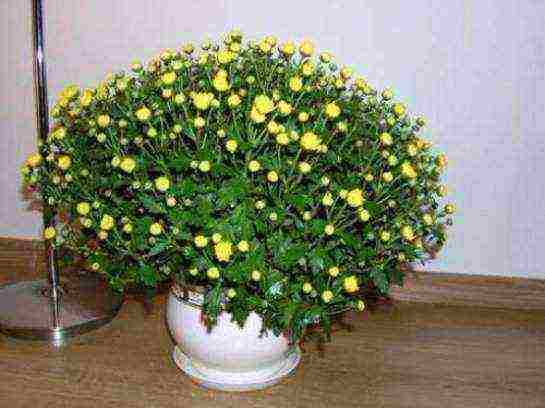
Watering
Chrysanthemums love moderate watering. With a lack of it, the stems will begin to wilt, and with an abundance, they will rot and become infected with a fungus. Experienced growers believe that sometimes it is better to underfill the chrysanthemum root than to pour too much. That is why these flowers are planted on a dais so that excess moisture can go down.
Make sure that there are no depressions or pits near the chrysanthemum. After rains, water can be retained in them, which will negatively affect the condition of the plant.
Some growers recommend spraying chrysanthemums with Fitosporin or another antifungal agent after each rain.
How to fertilize the soil for a chrysanthemum
Growing chrysanthemums in the country or at home must necessarily include the introduction of fertilizing. Since the flower needs an increased amount of nutrients, it is necessary to fertilize the soil near it, starting in spring. At the end of March-beginning of April, it is already possible to make nitrogen fertilizing. You can buy them in the store or make your own using a mullein. These types of fertilizers stimulate the growth of flowers. In spring and summer, when chrysanthemum bushes are just forming, this is just the way.
From the end of August, it is already necessary to apply potash and phosphate fertilizers. You can buy a combination remedy that includes them. These types of fertilizers promote bud growth and abundant flowering. The plant also needs them to accumulate resources for wintering.
Since the end of October, the chrysanthemum does not need any fertilizers. At this time, she is in the period of her abundant flowering.In November, you can already start preparing for the winter.
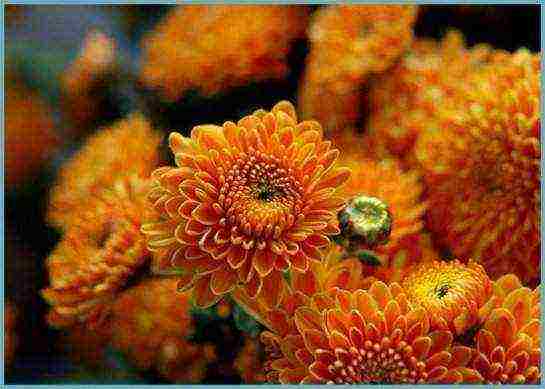
Pruning
Chrysanthemums should be pruned twice a year. In spring and summer, this is done in order to form a beautiful bush. In particular, the growing point on the top is removed from the plant. After that, lateral shoots begin to actively grow, and the chrysanthemum becomes lush. It is necessary to cut off the top a few days after planting the flower, then the procedure is repeated after 20 days.
If you have a spherical chrysanthemum, you do not need to pinch it. She will already grow as a lush bush in the shape of a dome. This is due to its varietal properties.
It is also necessary to prune the chrysanthemum in the fall. First of all, at this time, diseased, dry and rotten shoots are removed. This is done for sanitary purposes, so that the entire bush does not become infected in winter. Some growers also shorten all other shoots. But this should not always be done. The need for full pruning arises if you are going to cover the plant for the winter outdoors. In this case, you need to reduce the bush in volume so that it fits under the insulation frame. If you do not apply special measures for covering, then it is better not to cut off the top of the chrysanthemum. This can harm the plant.
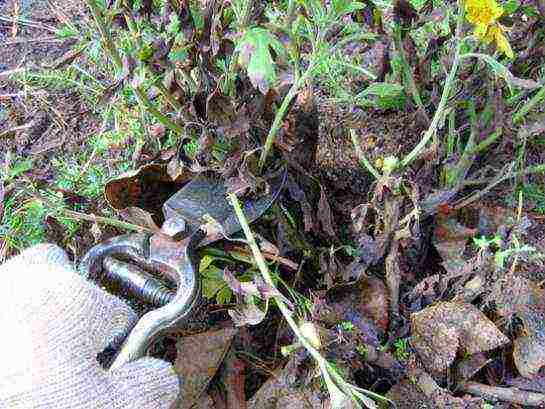
Treatment
Chrysanthemums, like any other flowers, can be susceptible to disease and also be attacked by pests. In such situations, it is important to take timely measures so that the infection does not kill the chrysanthemums and does not spread to neighboring flowers.
If the chrysanthemum is affected by a fungus, then spray it with Fitosporin or another similar preparation. Also, make sure that the moisture level is reduced in the area with flowers.
Powdery mildew sometimes appears on chrysanthemum. It is clearly visible on the affected leaves. It is necessary to deal with it by introducing potassium-phosphorus fertilizing, as well as reducing the level of moisture. Also, make sure that no water gets on the leaves when watering.
Chrysanthemum is also affected by ticks. They are neutralized with insecticides, which are sold in flower shops. The most effective is Karbofos.
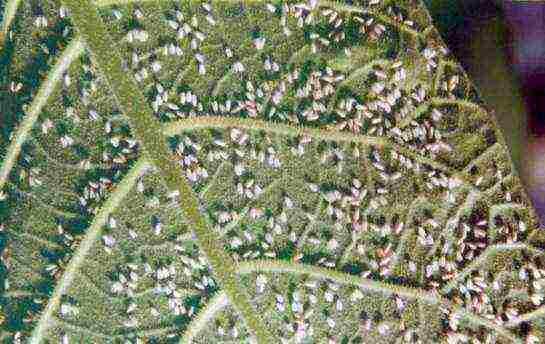
Preparing for winter
Care and cultivation of chrysanthemums in the country includes such a stage as preparation for wintering. It should start in September, when the plant is just getting ready to bloom. At this time, it is already necessary to apply potassium-phosphorus fertilizers. They will give the plant strength for wintering.
In November, when the leaves of the chrysanthemum begin to wither, it is worth thinking about hiding it for the winter. After sanitary pruning, you will need to build a frame over the plant, and then cover it with polyethylene or other insulating material. These measures will be sufficient for the wintering of a common chrysanthemum. But if your flower is not a frost-resistant variety, then it is better to dig it up by the roots and store it in the cellar until spring.
When implementing the care and cultivation of chrysanthemums in the country, remember that in the winter you will not be able to look after it. Therefore, it is better to put it in the cellar. So you can be sure that it will not freeze and will not stick.
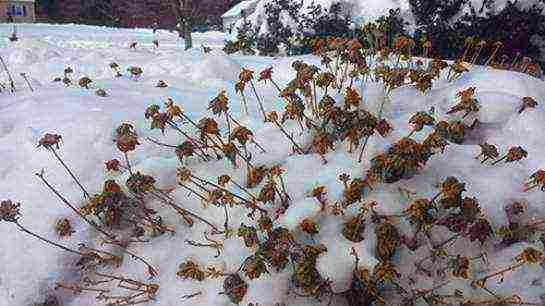
Reproduction
How to grow a chrysanthemum, it became clear to you from the previous sections of this article. But surely this information is not enough for amateur flower growers, but I would like not only to have a chrysanthemum on my site, but also to propagate it to several bushes. This can be done in several ways.
Cuttings
To reproduce in this way, you need a strong and healthy chrysanthemum branch. It is easy to choose it, since the condition can be judged by its appearance. A flower from a bouquet is also suitable for cuttings.
In order for the branch to take root, it must be sprinkled with a root former and planted in moist soil. At the same time, make sure that the earth does not dry out until the plant is well rooted. You can also put the cutting in a glass of water to take root in it. After that, the plant is planted in a flowerpot or open ground.
Separation of the rhizome
This method of breeding chrysanthemums is the simplest.You just need to dig out part of an already formed flower bush and transplant it separately. This is not difficult.
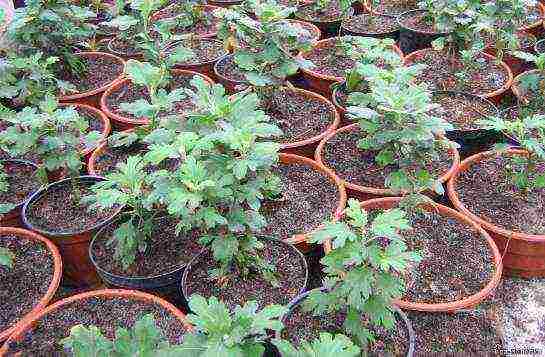
Reproduction through seeds
Can a chrysanthemum be grown from seeds? This method is indeed sometimes used. True, it is not suitable for spherical chrysanthemums, because they are artificially bred. If you plant seeds of Multiflora, then an ordinary chrysanthemum will grow without a hint of varietal characteristics.
Growing chrysanthemums from seeds at home can be carried out in seedlings. For this, a suitable box is selected and a loose, fertile earthen mixture is poured into it. Do not forget about high-quality drainage. After that, chrysanthemum seeds are planted at a depth of 25 centimeters. It is advisable to put 2-3 seeds in one hole. After the seedlings sprout and grow a little, it must be thinned out. You can also picket plants in separate disposable cups.
Chrysanthemum seedlings are planted in mid-February - early March. By May, the plants will be ready to be transplanted outside.
How to grow chrysanthemum seeds outdoors? To do this, they should be planted in early May in well-moistened soil. Thereafter, the flowers are often watered until germination. When the chrysanthemums sprout, they are thinned out. We hope that our article has answered the question: how to grow chrysanthemums at home. See also the video "Growing chrysanthemums at home."


